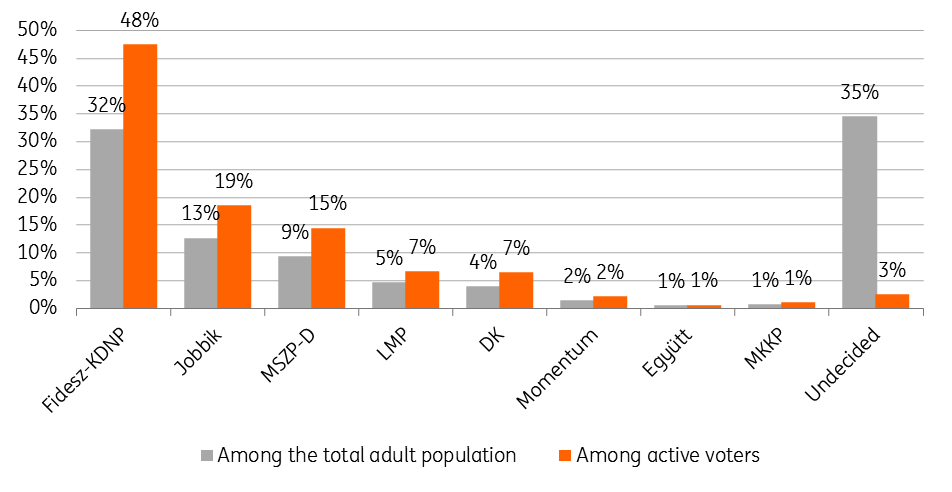Hungary: Ready, Steady, Vote!
Latest polls in Hungary suggest Sunday's elections could be won by Prime Minister, Viktor Orban's Fidesz-KDNP. But a hung parliament is not out of the question
Back to basics
Hungary's general election on 8 April could well throw up some surprises, but latest polls suggest Viktor Orban's Fidesz-KDNP (Fidesz) will get the most seats. But it's far from a done deal and we could even see a minority government.
To have a better understanding, we need to start with the basics. The electoral laws were changed in 2012 by Fidesz-KNDP. We have only one round without any type of turnout rule, which makes the opposition's life harder to coordinate. The 199 members of the National Assembly are elected by two methods; 106 will be elected in single-member constituencies by first-past-the-post voting, with the remaining 93 from a single nationwide constituency by proportional representation. A 5% threshold is in effect for party lists, 10% threshold for a joint list if there are two parties (like MSZP-Dialogue), 15% threshold for a joint list of three or more parties.
The recent Hungarian electoral system overcompensates the winner. From the constituency list, the winner can get extra votes based on his margin of victory. Let’s put it in a simple example. A Fidesz guy wins, getting 10,000 votes, the runner-up gets 5,000. The difference (5k) is added to the party list votes. This is why the opposition is trying to put only one candidate against Fidesz in most of the constituencies where Fidesz-KDNP seems to be weaker than the average.
Party preferences (March results)

Scenario – Fidesz-KNDP wins by simple majority
| 60% |
probability |
Based on the latest polls, Fidesz is still the most popular party among active voters. On average, 48% of the voters will plump for Fidesz, which should be more than enough to have the simple majority. It means no change compared to the past two years, as Fidesz won the previous election by a two-third majority but lost 3 seats in by-elections, falling back just below two-thirds in Parliament. So a simple majority means a no change scenario with the best possible market outcome: neutral to slight positive.
Hungarian polls had a reputation of being pretty good at predicting the result, but they did use to overestimate Fidesz and that's corrected by different methodologies, so some sort of uncertainty remains. If we take into consideration the recent cooperation between parties in the opposition, the accuracy of the polls could be under scrutiny. In our base case, the withdrawals from one party to help others won’t be enough to defeat Fidesz but could prevent a two-thirds majority.
It is hard to imagine a Jobbik (previously a far-right, now rather a centre-right party) voter would vote for an MSZP-D (socialist) nominee and vice versa. Recent surveys indicate a fair amount of voters are backing up the coordination and will try to vote accordingly, but it is far from certain that this will happen. In Hungary, a simple majority would be welcomed by most of the people and business as it means no change in taxation (flat 9% corporate income tax [CIT] and flat 15% personal income tax [PIT] and decreasing social security contribution). Recently, Mr Varga (Minister for National Economy) emphasised that Fidesz will continue its economic policy and foreshadowed a possible cut in the PIT to a single digit rate if Fidesz remains in power. On the other hand, all other parties would change the taxation to a progressive one when it comes to CIT and PIT. However, without a 2/3 majority, to the latter is not possible as the flat rate PIT is incorporated in the constitution.
Scenario – Fidesz-KDNP wins by two-thirds majority
| 20% |
probability |
We still have some 30-40% of undecided voters, according to the latest polls, who either won’t vote or will opt for someone who is not considered ‘sexy’ in front of the public. So we need to reveal who isn't that attractive. In our view, it is either the Jobbik or the governing force Fidesz. Moreover, if voters should decide only between Fidesz or a leftist party (due to the coordinated withdrawals), the majority of Jobbik voters would vote rather for Fidesz.
The bottom line is that Fidesz seems to be too strong to be defeated, as the electoral system was changed which appeared to favour of the governing party. From a market point of view, some turbulence is expected, but nothing harsh or long-lasting if Fidesz wins by a constitutional majority. At the end of the day, when it comes to the economic policy, it won't matter whether Fidesz has a two-thirds or only a simple majority. Fiscal policy to remain strict, debt-to-GDP reduction remains important as well as reaching sovereign rating upgrades. Monetary policy to remain accommodative. Taxation unchanged with emphasis on decreasing the tax burden on labour, and a continued fight against the shadow economy. However, the corruption perceived by companies might also remain unchanged. The only caveat of the two-thirds majority is the power without control, which can be tempting not to make confrontational changes.
Scenario – Opposition wins by simple majority
| 10% |
probability |
Let’s assume coordination works, voters want someone new but definitely not Fidesz; far-right voters are happy to vote for left or left to far-right, just to make sure Fidesz is out of the power. This outcome means huge uncertainty because the winner needs to find coalition partners. Based on the latest communication of the opposition, parties would be ready to form a short-term coalition, just to change the constitution and the electoral system and would set up new elections.
The bottom line is: significant market turbulence and sell-off might happen, especially if some of the parties are trying to overpower others and can't compromise on the new rules. Because a lot of laws need to be changed - according to the opposition - it would take more time than anybody thinks. In the worst case, it can lead us to a long-lasting negotiation process and a lost opportunity for stability.
Scenario – Opposition wins by 2/3 majority
| 5% |
Probability |
Fidesz biggest threat is ex-friend of Orbán, now a supporter of Jobbik (Lajos Simicska). Mr Simicska might or might not have something up in his sleeve, let’s say a political nuclear bomb against Fidesz, which could be dropped only days before the election, ruling out a well-organised reaction by Fidesz. We see this is the only chance for the opposition to have a landslide win, but as we are as close to the election as we are, it seems less and less likely this will happen.
As for the effect such a scenario would have, it is important to note that we don’t know what Jobbik would do with its power, assuming that the second strongest party would win. It seems now they are not against EU, but still definitely not a friend of multinationals and foreigners. This provides a high uncertainty/high-risk scenario for markets, with even a bigger sell-off than a simple majority win for the opposition.
Scenario – Minority win by Fidesz
| 5% |
Probability |
Fidesz changed the electoral system in such a way that chances of a hung parliament are relatively low. However, it could happen, but because of the overcompensation of the winner, it is hard to imagine. The opposition should win a lot of seats via single constituencies to have a real shot at this scenario. However, if it were the case, Fidesz has two opportunities: governing in minority or having a coalition.
We’d rather rule out the latter, as no one from the opposition would form a coalition. Jobbik (because of Simicska) is a no-go for Fidesz. MSZP-D is a no go because of historical reasons. LMP (the green party) is rather close to Jobbik or the left than to Fidesz. DK (headed by ex-PM Gyurcsány) is another no-go. All in all, no viable option for Fidesz, so they would either buy some votes when needed or just try to create chaos, "set the country on fire", then go for a new election within one year. The Fidesz itself announced that in such a case (minority win), it would rather have the minority option than form a coalition. This seems to be the worst case scenario, especially if Fidesz tries to prove a point that the country collapses without a clear Fidesz leadership.
Market reaction using HUF as a gauge
Scenario 1-2 is rather HUF positive. We see the EUR/HUF around 303 by end-18: A strong credit story, no political risk, sound fiscal stance, the same monetary policy, strong C/A balance, possible rating upgrades.
All in all, our base case scenario involves permanent but slow strengthening of HUF. However, should we see scenario 3-4 come alive, a quick sell-off might happen with HUF weakening temporarily to around 320 vs EUR. As the picture becomes more clear, HUF will strengthen back by the year-end to its starting level (310-312). Scenario 5 means a country with a government willing to prove a point, thus EUR/HUF could weaken even above 320 in the short-term and hopefully stabilise somewhere around this level until there is no resolution.
Download
Download opinion
Peter Virovacz
Peter Virovacz is a Senior Economist in Hungary, joining ING in 2016. Prior to that, he has worked at Szazadveg Economic Research Institute and the Fiscal Council of Hungary. Peter studied at the Corvinus University of Budapest.
Peter Virovacz
This publication has been prepared by ING solely for information purposes irrespective of a particular user's means, financial situation or investment objectives. The information does not constitute investment recommendation, and nor is it investment, legal or tax advice or an offer or solicitation to purchase or sell any financial instrument. Read more
